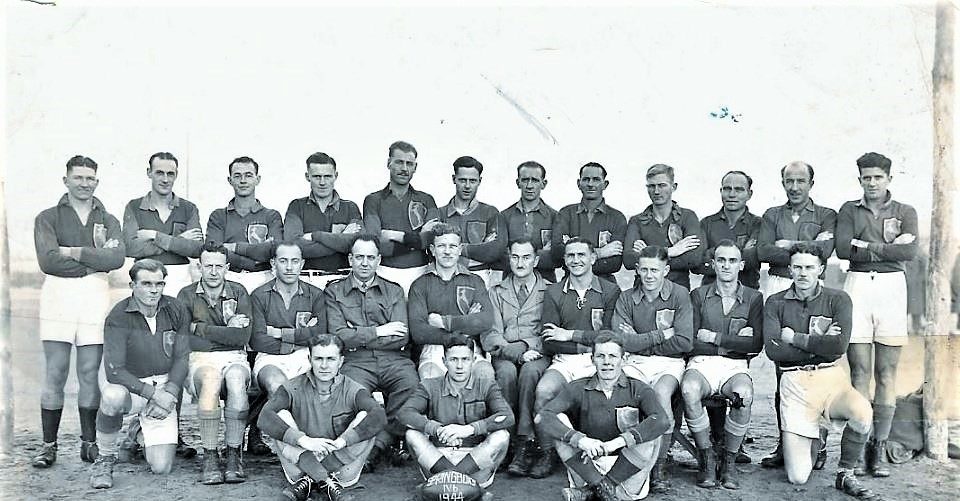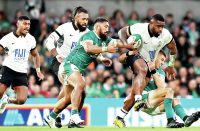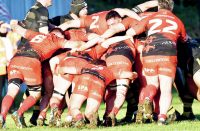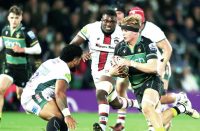LIFE in German prisoner of war camps was hard mentally and physically and although escaping and/or survival were the major obsessions, rugby played its part in maintaining morale. Indeed at some camps it did more than that and international competitions of a very decent standard were held and reported on in underground POW newspapers.
Just such a camp was Stalag 1VB near Muhlberg on the Elbe River which was purpose-built in 1939 and among the most secure of POW camps which at its height imprisoned 21,000 troops including 8,000 British and Empire servicemen.
Many were decent rugby players and the catalyst to ignite all that came in the autumn of 1943 when a contingent of 700 South Africans arrived after being captured in North Africa. They were an energetic bunch containing a good sprinkling of useful provincial and club rugby players and one future Springbok in Fiks van der Merwe. Transvaal full-back Gus Ackermann had also been tipped for Springbok honours before the War intervened.
With the South Africans to the fore, a 32-strong Hut League started up, making use of the large, grassy parade grounds where the Germans permitted sport to be played during the ample free time. Inevitably there was soon talk of escalating the Hut League and staging a few ‘internationals’. South Africa threw down the gauntlet for others to pick up.
An ANZAC XV were lined up to play the Boks but first came the challenge of kitting out the South African team. The Red Cross had delivered a consignment of balls and whistles and also a large number of long-sleeved white vests but that was about all. The latter were transformed to green jerseys by using the dye from the uniforms of Russian and Italian soldiers in camp. For the gold collars, cuffs and sock tops, the camp medics dissolved a quantity of the large stockpile of anti-malaria tablets they possessed while former tailors devised and sewed in a Springbok emblem.
For the boots a number of former cobblers in camp stepped forward. The rugby boots were basically well-worn regulation Army boots with the heels removed. From those heels six studs were fashioned and attached to the soles of boots. And for laces the strong twine used to tie the various Red Cross parcels served very nicely. The troops’ cigarette rations were used to bribe some of the German guards for bits and pieces – mostly shorts – while ahead of the game those not playing volunteered some of their meagre rations for those who were participating. Although there seem to be no surviving pictures of South Africa’s opponents we can safely assume that the same process occurred in getting them kitted out.
A set of posts were fashioned from hut planks and a surviving German map of the camp clearly shows a well-marked combined rugby and football pitch on one of the parade grounds.
Come the first match and the ANZACS were not quite as strong as might be expected – there wasn’t a big contingent of Australians and Kiwis at Stalag 1VB and they weren’t spoilt for choice. South Africa, however, were not happy with their 21-0 win and the versatile van der Merwe decided to move himself from scrum-half to No.8 where he could have more influence on affairs.
National pride was stirring and a fixture with Wales, who boasted a strong contingent in camp, had already been confirmed when the other three Home Unions offered to field a combined side and the game was slotted in before the Wales match, with South Africa being pressed hard before winning 14-3.
Then came the much anticipated clash with the Welsh, who were also defeated 14-3, and by now these Test matches were assuming considerable importance in camp life and there were two more challenges for the Springboks to meet.
To celebrate South Africa’s Union Day – May 31 up until 1960 when it became a Republic – they had accepted an invitation to take on ‘The Rest of the World’ while Wales, despite the 14-3 defeat, felt they were hard done by the score line and immediately requested a replay.
The secretly printed camp paper Observer – written on wallpaper – chronicled the day. A crowd of 2,000 had already gathered some half an hour before kick off. Another illicit camp publication the 5-O-News reports spectators had to be turned away. Pre-match entertainment was provided by the non-playing South Africans who paraded as Zulu warriors with improvised shields made from cardboard Red Cross Parcels.
It was a ferocious affair but the Boks scored a vital try midway through the half when van der Merwe made a break from deep and beat half the Rest team before passing on to Moore to score.
Ackermann increased the Springboks lead with a penalty after the break and the closing stages were all South Africa with their stand-out backs Fabricus and Schaefer both going close before van der Westhuizen closed out the game with a second try for the Boks.
Afterwards it was all back to the Empire Theatre – a bigger than usual hut used for meetings and drama productions – for a time-honoured social. No beer, alas, but biscuits, tea, extra German bread bribed from the guards and much good fellowship, culminating with the communal singing of national anthems.
The following week came a torrid 3-0 win over Wales but after that the rugby abruptly stopped. The condition of many prisoners was deteriorating and, with escape attempts increasing, there was also a general clampdown by the Germans.























